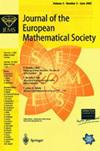Cutoff for non-negatively curved Markov chains
IF 2.9
1区 数学
Q1 MATHEMATICS
引用次数: 20
Abstract
Discovered in the context of card shuffling by Aldous, Diaconis and Shahshahani, the cutoff phenomenon has since then been established in a variety of Markov chains. However, proving cutoff remains a delicate affair, which requires a detailed knowledge of the chain. Identifying the general mechanisms underlying this phase transition -- without having to pinpoint its precise location -- remains one of the most fundamental open problems in the area of mixing times. In the present paper, we make a step in this direction by establishing cutoff for Markov chains with non-negative curvature, under a suitably refined product condition. The result applies, in particular, to random walks on abelian Cayley expanders satisfying a mild degree condition, hence in particular to \emph{almost all} abelian Cayley graphs. Our proof relies on a quantitative \emph{entropic concentration principle}, which we believe to lie behind all cutoff phenomena.非负弯曲马尔可夫链的截断
截断现象是Aldous, Diaconis和Shahshahani在洗牌过程中发现的,此后在各种马尔可夫链中建立了截断现象。然而,证明切断仍然是一件微妙的事情,这需要对链条有详细的了解。在不确定其精确位置的情况下,确定这种相变的一般机制仍然是混合时间领域中最基本的开放问题之一。在本文中,我们在一个适当的精炼乘积条件下,通过建立非负曲率马尔可夫链的截止点,在这个方向上迈出了一步。该结果特别适用于满足温和度条件的阿贝尔凯利展开上的随机漫步,因此特别适用于\emph{几乎所有}的阿贝尔凯利图。我们的证明依赖于定量的\emph{熵集中原理},我们相信它隐藏在所有截断现象的背后。
本文章由计算机程序翻译,如有差异,请以英文原文为准。
求助全文
约1分钟内获得全文
求助全文
来源期刊
CiteScore
4.50
自引率
0.00%
发文量
103
审稿时长
6-12 weeks
期刊介绍:
The Journal of the European Mathematical Society (JEMS) is the official journal of the EMS.
The Society, founded in 1990, works at promoting joint scientific efforts between the many different structures that characterize European mathematics. JEMS will publish research articles in all active areas of pure and applied mathematics. These will be selected by a distinguished, international board of editors for their outstanding quality and interest, according to the highest international standards.
Occasionally, substantial survey papers on topics of exceptional interest will also be published. Starting in 1999, the Journal was published by Springer-Verlag until the end of 2003. Since 2004 it is published by the EMS Publishing House. The first Editor-in-Chief of the Journal was J. Jost, succeeded by H. Brezis in 2004.
The Journal of the European Mathematical Society is covered in:
Mathematical Reviews (MR), Current Mathematical Publications (CMP), MathSciNet, Zentralblatt für Mathematik, Zentralblatt MATH Database, Science Citation Index (SCI), Science Citation Index Expanded (SCIE), CompuMath Citation Index (CMCI), Current Contents/Physical, Chemical & Earth Sciences (CC/PC&ES), ISI Alerting Services, Journal Citation Reports/Science Edition, Web of Science.

 求助内容:
求助内容: 应助结果提醒方式:
应助结果提醒方式:


